Mahadeva may refer to:
Mahadeva may refer to:

In Buddhism, Avalokiteśvara, also known as Lokeśvara and Chenrezig, is a tenth-level bodhisattva associated with great compassion (mahakaruṇā). He is often associated with Amitabha Buddha. Avalokiteśvara has numerous manifestations and is depicted in various forms and styles. In some texts, he is even considered to be the source of all Hindu deities.

Anagārika Dharmapāla was a Sri Lankan Buddhist revivalist and a writer.
Since the death of the historical Buddha, Siddhartha Gautama, Buddhist monastic communities ("sangha") have periodically convened to settle doctrinal and disciplinary disputes and to revise and correct the contents of the Buddhist canons. These gatherings are often termed Buddhist "councils". Accounts of these councils are recorded in Buddhist texts as having begun immediately following the death of the Buddha and have continued into the modern era. The earliest councils are regarded as real events by every Buddhist tradition. However, the historicity and details of these councils remains a matter of dispute in modern Buddhist studies. This is because various sources belonging to different Buddhist schools contain conflicting accounts of these events and the narratives often serve to bolster the authority and prestige of specific schools.

Mahāvaṃsa is the meticulously kept historical chronicle of Sri Lanka until the period of Mahasena of Anuradhapura. It was written in the style of an epic poem written in the Pali language. It relates the history of Sri Lanka from its legendary beginnings up to the reign of Mahasena of Anuradhapura covering the period between the arrival of Prince Vijaya from India in 543 BCE to his reign and later updated by different writers. It was first composed by a Buddhist monk named Mahanama at the Mahavihara temple in Anuradhapura in the 5th or 6th-century CE.
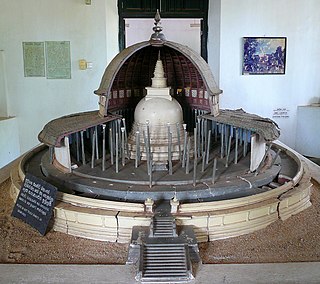
The Anuradhapura Maha Viharaya was an important mahavihara or large Buddhist monastery for Theravada Buddhism in Sri Lanka. King Devanampiya Tissa of Anuradhapura founded it in his capital city of Anuradhapura. Monks such as Buddhaghosa and Dhammapala, who wrote commentaries on the Tipitaka and texts such as the Visuddhimagga, which are central to Theravada Buddhist doctrine, established Theravada Mahaviharan orthodoxy here. Monks living at the Mahavihara were referred to as Mahaviharavasins.
Mahadev may refer to:

Theravada Buddhism is the largest and official religion of Sri Lanka, practiced by 70.2% of the population as of 2012. Practitioners of Sri Lankan Buddhism can be found amongst the majority Sinhalese population as well as among the minority ethnic groups. Sri Lankan Buddhists share many similarities with Southeast Asian Buddhists, specifically Myanmar Buddhists and Thai Buddhists due to traditional and cultural exchange. Sri Lanka is one of five nations with a Theravada Buddhist majority.
Ketheeswaram temple is an ancient Hindu temple in Mannar, Northern Province, Sri Lanka. It is the oldest temple in Sri Lanka with at least 1400 years of evidence. Overlooking the ancient Tamil port towns of Manthai and Kudiramalai, the temple has lain in ruins, been restored, renovated and enlarged by various royals and devotees throughout its history. Thirukketheeswaram is one of the Pancha Ishwarams dedicated to the Hindu deity Shiva and is venerated by Shaivas throughout the continent. Throughout its history, the temple has been administered and frequented by Sri Lankan Hindu Tamils. Its famous tank, the Palavi tank, is of ancient antiquity and was restored from the ruins. Thirukketheeswaram is one of the 275 Paadal Petra Sthalams of Shiva glorified in the poems of the Tevaram.

Buddhist art is visual art produced in the context of Buddhism. It includes depictions of Gautama Buddha and other Buddhas and bodhisattvas, notable Buddhist figures both historical and mythical, narrative scenes from their lives, mandalas, and physical objects associated with Buddhist practice, such as vajras, bells, stupas and Buddhist temple architecture. Buddhist art originated in the north of the Indian subcontinent, in modern India, Pakistan and Afghanistan, with the earliest survivals dating from a few centuries after the historical life of Siddhartha Gautama from the 6th to 5th century BCE.
Village deities are a common feature of the Hindu pantheon of deities. They are known as Gramadevatas. Each Hindu region and caste of India and South Asia has its share of village deities. Sri Lankan Tamils venerate their own group of village deities throughout Sri Lanka, specifically in the Tamil-dominated north and east of the island nation.
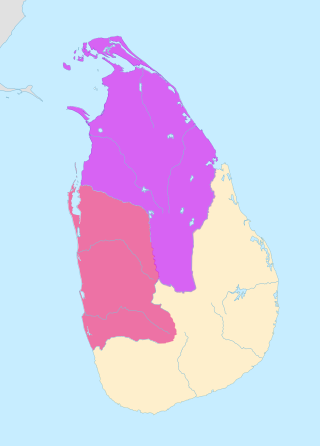
The Kingdom of Polonnaruwa was the Sinhalese kingdom that expanded across the island of Sri Lanka and several overseas territories, from 1070 until 1232. The kingdom started expanding its overseas authority during the reign of Parakramabahu the Great.
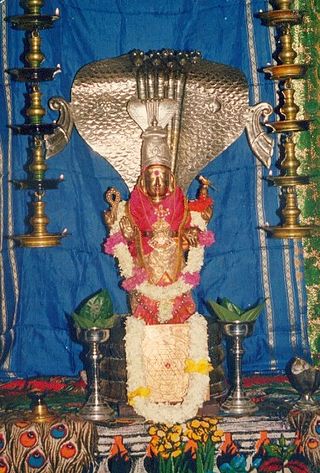
The Naga people are believed by some to be an ancient tribe who once inhabited Sri Lanka and various parts of Southern India. There are references to Nagas in several ancient texts such as Mahavamsa, Manimekalai, Mahabharata and also in other Sanskrit and Pali literature. They were generally represented as a class of super-humans taking the form of serpents who inhabit a subterranean world.
Theravada Buddhism is the state religion of Cambodia, which has been present since at least the 5th century.
Sinhalese Buddhist nationalism is a Sri Lankan political ideology which combines a focus upon Sinhalese culture and ethnicity (nationalism) with an emphasis upon Theravada Buddhism, which is the majority belief system of most of the Sinhalese in Sri Lanka. It mostly revived in reaction to the colonisation of Sri Lanka by the British Empire and became increasingly assertive in the years following the independence of the country.
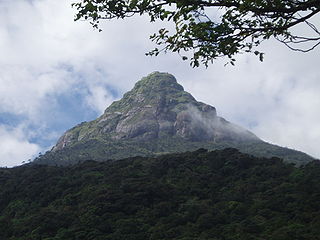
Adam's Peak is a 2,243 m (7,359 ft) tall conical sacred mountain located in central Sri Lanka. It is well known for the Sri Pada, a 1.8 m rock formation near the summit whose name is also used for the mountain itself. In Buddhist tradition the print is held to be the footprint of the Buddha, in Sri Lankan Hindu tradition that of Hanuman or Shiva, and in some Islamic and Christian traditions that of Adam or St. Thomas.

Kataragama temple in Kataragama, Sri Lanka, is a temple complex dedicated to Buddhist guardian deity Kataragama deviyo and Hindu War God Murugan. It is one of the few religious sites in Sri Lanka that is venerated by the Buddhists, Hindus, Muslims and the Vedda people. For most of the past millennia, it was a jungle shrine very difficult to access; today it is accessible by an all-weather road. The shrines and the nearby Kiri Vehera are managed by Buddhists, the shrines dedicated to Teyvāṉai and Shiva are managed by Hindus and the mosque by Muslims.
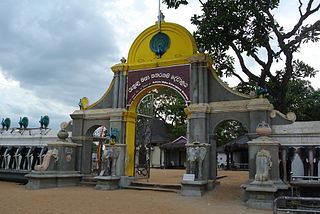
Kataragama is a pilgrimage town sacred to Hindu, Buddhist and indigenous Vedda people of Sri Lanka. People from South India also go there to worship. The town has the Kataragama temple, a shrine dedicated to Skanda Kumara also known as Kataragama deviyo. Kataragama is located in the Monaragala District of Uva province, Sri Lanka. It is 228 km (142 mi) southeast of Colombo. Although Kataragama was a small village in medieval times, today it is a fast-developing township surrounded by jungle in the southeastern region of Sri Lanka.

Buddhism amongst the Tamils was historically found in the Tamilakam region of India and Sri Lanka.

Bhante Kumar Kashyap Mahasthavir was a Nepalese Buddhist monk who was awarded the title of Tripitakacharya.

The banishment of Buddhist monks from Nepal was part of a campaign by the Rana government to suppress the resurgence of Theravada Buddhism in Nepal in the early the 20th century. There were two deportations of monks from Kathmandu, in 1926 and 1944.